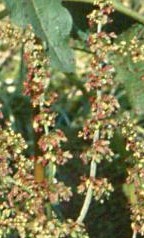 Broadleaf dock, also called bitter dock, is a perennial native to Europe but is now found throughout the United States and southern Canada. It prefers partial to moist, shady, disturbed sites and makes its home in fields, waste areas, and gardens.
Broadleaf dock, also called bitter dock, is a perennial native to Europe but is now found throughout the United States and southern Canada. It prefers partial to moist, shady, disturbed sites and makes its home in fields, waste areas, and gardens.
 Description: Plants appear in spring as basal rosettes made up of large, broad leaves up to 6” wide and 12” long, with reddish veined petioles. The leaf margins are slightly wavy and as the leaf color becomes reddish-purple as the leaves age.
Description: Plants appear in spring as basal rosettes made up of large, broad leaves up to 6” wide and 12” long, with reddish veined petioles. The leaf margins are slightly wavy and as the leaf color becomes reddish-purple as the leaves age.  A single, erect flowering stem grows up to 1-4 feet high and produces flowers in clusters of racemes during the summer. The flowers are small and have green sepals that turn reddish brown as they age. The seeds have toothed winged structures that facilitate dispersal by wind, water, animals, and machinery. A single mature dock plant can produce 60,000 seeds that can remain viable in the soil for up to 50 years. The root is a fleshy taproot that can reach 5 feet in length. Broadleaf dock resembles curly dock but can be distinguished from it by its larger leaves with less wavy margins.
A single, erect flowering stem grows up to 1-4 feet high and produces flowers in clusters of racemes during the summer. The flowers are small and have green sepals that turn reddish brown as they age. The seeds have toothed winged structures that facilitate dispersal by wind, water, animals, and machinery. A single mature dock plant can produce 60,000 seeds that can remain viable in the soil for up to 50 years. The root is a fleshy taproot that can reach 5 feet in length. Broadleaf dock resembles curly dock but can be distinguished from it by its larger leaves with less wavy margins.

 Control: Dock can be difficult to control because of its prolific seed production of long-lived seeds and the tendency of its root to resprout when cut. Digging young plants out before they form a deep taproot is especially desirable and flowering stems should be removed before they set seed. Herbicides such as glyphosate are useful for removing individual pesky plants that commonly appear in gardens.
Control: Dock can be difficult to control because of its prolific seed production of long-lived seeds and the tendency of its root to resprout when cut. Digging young plants out before they form a deep taproot is especially desirable and flowering stems should be removed before they set seed. Herbicides such as glyphosate are useful for removing individual pesky plants that commonly appear in gardens.